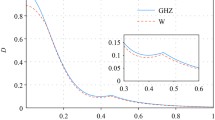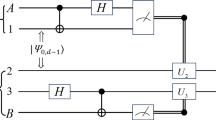Abstract
Information-theoretically secure authentication is necessary to guarantee both the authenticity and integrity of the data transferred over the channel in quantum key agreement (QKA). Generally speaking, QKA uses quantum resources to negotiate a unique shared key for every communication; consequently, as the number of communications rises, so does the quantity of quantum key resources used. A secure mutual authentication QKA scheme for the two-party setting with key recycling is proposed, based on single-photon states and Bell states, to realize mutual authentication and minimize quantum key consumption. The proposed protocol generates symmetric keys and authenticates each other using quantum states. Multiple rounds of communication can be accomplished with different keys when combined with key recycling. Additionally, security analysis and efficiency comparison show that our scheme can achieve desirable results with existing quantum technologies.

Similar content being viewed by others
Data availability
The authors confirm that the data supporting the findings of this study are available within the article.
References
Li, X.-Y., Zhao, Y.-L., Nag, A., et al.: Key-recycling strategies in quantum-key-distribution networks. Appl. Sci. 10(11), 3734 (2020)
Shor, P.W.: Algorithms for quantum computation: discrete logarithms and factoring. In Proceedings 35th Annual Symposium on Foundations of Computer Science, pp. 124–134 (1994)
He, Y.-F., Ma, W.-P.: Two-party quantum key agreement against collective noise. Quantum Inf. Process. 15(12), 5023–5035 (2016)
He, Y.-F., Ma, W.-P.: Quantum key agreement protocols with four-qubit cluster states. Quantum Inf. Process. 14(9), 3483–3498 (2015)
Shi, R.-H.: Useful equations about bell states and their applications to quantum secret sharing. IEEE Commun. Lett. 24(2), 386–390 (2020)
Song, D., Chen, D.-X.: Quantum key distribution based on random grouping Bell state measurement. IEEE Commun. Lett. 24(7), 1496–1499 (2020)
Kun-Fei, Yu., Yang, C.-W., Liao, C.-H., et al.: Authenticated semi-quantum key distribution protocol using Bell states. Quantum Inf. Process. 13(6), 1457–1465 (2014)
Gao, G.: Quantum key distribution by comparing Bell states. Opt. Commun. 281(4), 8876–8879 (2008)
He, Y.-F., Pang, Y.-B., Di, M.: Mutual authentication quantum key agreement protocol based on Bell states. Quantum Inf. Process. 21(8), 290 (2022)
Yang, Y.-G., Li, B.-R., Li, D., et al.: New quantum key agreement protocols based on Bell states. Quantum Inf. Process. 18(10), 322 (2019)
Cao, H., Ma, W.-P.: Efficient multi-party quantum key agreement protocol based on nonorthogonal quantum entangled pairs. Laser Phys. Lett. 15(9), 095201 (2018)
Min, S.-Q., Chen, H.-Y., Gong, L.-H.: Novel multi-party quantum key agreement protocol with G-like states and bell states. Int. J. Theor. Phys. 57(6), 1811–1822 (2018)
Zhou, N., Zeng, G.-H., Xiong, J.: Quantum key agreement protocol. Electron. Lett. 40(18), 1149–1150 (2004)
Shen, D.-S., Ma, W.-P., Wang, L.-l: Two-party quantum key agreement with four-qubit cluster states. Quantum Inf. Process. 13(10), 2313–2324 (2014)
Yang, Y.-G., Gao, S., Li, D., et al.: Two-party quantum key agreement over a collective noisy channel. Quantum Inf. Process. 18(3), 74 (2019)
Ye-Feng He, Y.-R., Di Yue, M., et al.: Two-party mutual authentication quantum key agreement protocol. Int. J. Theor. Phys. 61(5), 145 (2022)
Huang, Xi., Zhang, S.-B., Chang, Y., et al.: Quantum key agreement protocol based on quantum search algorithm. Int. J. Theor. Phys. 60(3), 838–847 (2021)
Zhu, H.-F., Wang, L.-W., Zhang, Y.-L.: An efficient quantum identity authentication key agreement protocol without entanglement. Quantum Inf. Process. 19(10), 381 (2020)
Jiang, S.-X., Fang, L., Fang, X.-J.: Two-party quantum key agreement with six-particle entangled states against collective noise. Int. J. Theor. Phys. 62(10), 235 (2023)
Yu-Guang, Xu., Wang, C.-N., Cheng, K.-F., et al.: A novel three-party mutual authentication quantum key agreement protocol with GHZ states. Int. J. Theor. Phys. 61(10), 245 (2022)
Yi-Ting, Wu., Chang, H., Guo, G.-D., et al.: Multi-party quantum key agreement protocol with authentication. Int. J. Theor. Phys. 60(11), 4066–4077 (2021)
Liu, H.-N., Liang, X.-Q., Jiang, D.-H., et al.: Multi-party quantum key agreement with four-qubit cluster states. Quantum Inf. Process. 18(8), 242 (2019)
Zhu, H.-F., Wang, C.-N., Li, Z.-X.: Semi-honest three-party mutual authentication quantum key agreement protocol based on GHZ-like state. Int. J. Theor. Phys. 60(1), 293–303 (2021)
Ma, X.-Y., Hur, J., Li, Z.-X., et al.: Quantum mutual authentication key agreement scheme using five-qubit entanglement towards different realm architecture. Int. J. Theor. Phys. 60(5), 1933–1948 (2021)
Fehr, S., Salvail, L.: Quantum authentication and encryption with key recycling. In: Coron, J.S., Nielsen, J. (eds.) Advances in Cryptology – EUROCRYPT 2017. Lecture Notes in Computer Science, vol. 10212. Springer, Cham (2017)
Wegman, M., Carter, L.: New hash functions and their use in authentication and set equality. J. Comput. Syst. Sci. 22(3), 265–279 (1981)
Rogaway, P.: Bucket hashing and its application to fast message authentication. J. Cryptol. 12, 91–115 (1999)
Portmann, C.: Key recycling in authentication. IEEE Trans. Inform. Theory. 60(7), 4383–4396 (2014)
Hayden, P., Leung, D.W., Mayers, D.: The Universal composable security of quantum message authentication with key recyling. arXiv: Quantum Physics, 2016, https://arxiv.org/abs/1610.09434
Fehr, S., Salvail, L.: Quantum authentication and encryption with key recycling. In Proceedings of the Annual International Conference on the Theory, Applications of Cryptographic Techniques, Paris, France, pp. 311–338 (2017)
Li, Q., Zhao, Q., Le, D., et al.: Study on the security of the authentication scheme with key recycling in QKD. Quantum Inf. Process. 15(9), 3815–3831 (2016)
Yu-Guang, Xu., Chen, L.-Y., Zhu, H.-F.: Quantum key distribution scheme with key recycling in integrated optical network. Int. J. Theor. Phys. 62(5), 103 (2023)
Cabello, A.: Quantum key distribution in the Holevo limt. Phys. Rev. Lett. 85(26), 5635–5638 (2000)
Acknowledgements
This work was supported by the Science and Technology Research Program of Chongqing Municipal Education Commission (Grant Nos. KJQN202302401, KJQN202202401, KJQN202202402).
Author information
Authors and Affiliations
Contributions
CW contributed to the conception of the study and wrote the main manuscript text; QZ draw the figure; CW and SL implement the code; HZ helped perform the analysis with constructive discussion; All authors reviewed the manuscript.
Corresponding author
Ethics declarations
Conflict of interest
The authors declared that they have no conflicts of interest to this work.
Additional information
Publisher's Note
Springer Nature remains neutral with regard to jurisdictional claims in published maps and institutional affiliations.
Appendix
Appendix
Suppose \(N = 4\), \(K_0 = 0010\), Alice and Bob use \(K_0\) to authenticate each other. The example of MAQKA protocol without considering decoy states, then {\(S_{A1}^1\), \(S_{A2}^1\)} and {\(S_{B1}^1\), \(S_{B2}^1\)} are expressed as follows (The code is available at https://github.com/CNanWang/Secure-MAQKA-for-Two-party, and the execution results have been uploaded as Result_1, Result_2, Result_3, and Result_4):
{\(K_A^1\), \(OS_A^1\), \(T_A^0\), \(T_A^1\), \(T_A^2\)} and {\(K_B^1\), \(OS_B^1\), \(T_B^0\), \(T_B^1\), \(T_B^2\)} are shown in Tables
4 and
5, respectively. According to \(T_A^0\), \(T_A^1\), and \(T_A^2\), the detailed process of Alice getting \(K_1\) is as follows:
-
1.
\(\left\{ {T_A^0 \left[ 1 \right] =^{\prime} 00^{\prime} } \right\} = \left\{ {T_A^1 \left[ 1 \right] =^{\prime} 00^{\prime} } \right\}\) and \(\left\{ {T_A^1 \left[ 1 \right] = ^{\prime}00^{\prime}} \right\} \ne \left\{ {T_A^2 \left[ 1 \right] = ^{\prime}10^{\prime}} \right\}\):
Alice performed Pauli-I operation on \(P_{a1}^1 \left( 2 \right)\), \(OS_A^1 \left[ 1 \right] = I \Leftrightarrow K_A^1 \left[ 1 \right] = 0\);
Bob performed Pauli-Z operation on \(P_{a1}^1 \left( 2 \right)\), \(OS_B^1 \left[ 1 \right] = Z \Leftrightarrow K_B^1 \left[ 1 \right] = 1\);
-
2.
\(\left\{ {T_A^0 \left[ 2 \right] = ^{\prime}01^{\prime}} \right\} \ne \left\{ {T_A^1 \left[ 2 \right] = ^{\prime}11^{\prime}} \right\}\) and \(\left\{ {T_A^1 \left[ 2 \right] = ^{\prime}11^{\prime}} \right\} \ne \left\{ {T_A^2 \left[ 2 \right] = ^{\prime}01^{\prime}} \right\}\):
Alice performed Pauli-Z operation on \(P_{a2}^1 \left( 2 \right)\), \(OS_A^1 \left[ 2 \right] = Z \Leftrightarrow K_A^1 \left[ 2 \right] = 1\);
Bob performed Pauli-Z operation on \(P_{a2}^1 \left( 2 \right)\), \(OS_B^1 \left[ 2 \right] = Z \Leftrightarrow K_B^1 \left[ 2 \right] = 1\);
-
3.
\(\left\{ {T_A^0 \left[ 3 \right] = ^{\prime}11^{\prime}} \right\} = \left\{ {T_A^1 \left[ 3 \right] = ^{\prime}11^{\prime}} \right\}\) and \(\left\{ {T_A^1 \left[ 3 \right] = ^{\prime}11^{\prime}} \right\} = \left\{ {T_A^2 \left[ 3 \right] = ^{\prime}11^{\prime}} \right\}\):
Alice performed Pauli-I operation on \(P_{a3}^1 \left( 2 \right)\), \(OS_A^1 \left[ 3 \right] = I \Leftrightarrow K_A^1 \left[ 3 \right] = 0\);
Bob performed Pauli-I operation on \(P_{a3}^1 \left( 2 \right)\), \(OS_B^1 \left[ 3 \right] = I \Leftrightarrow K_B^1 \left[ 3 \right] = 0\);
-
4.
\(\left\{ {T_A^0 \left[ 4 \right] = ^{\prime}11^{\prime}} \right\} \ne \left\{ {T_A^1 \left[ 4 \right] = ^{\prime}01^{\prime}} \right\}\) and \(\left\{ {T_A^1 \left[ 4 \right] = ^{\prime}01^{\prime}} \right\} \ne \left\{ {T_A^2 \left[ 4 \right] = ^{\prime}11^{\prime}} \right\}\):
Alice performed Pauli-Z operation on \(P_{a4}^1 \left( 2 \right)\), \(OS_A^1 \left[ 4 \right] = Z \Leftrightarrow K_A^1 \left[ 4 \right] = 1\);
Bob performed Pauli-Z operation on \(P_{a4}^1 \left( 2 \right)\), \(OS_B^1 \left[ 4 \right] = Z \Leftrightarrow K_B^1 \left[ 4 \right] = 1\);
Therefore, Alice gets \(K_B^1 = 1101\) and computes \(K_1 = K_0 \oplus K_A^1 \oplus K_B^1 = 1010\).
According to \(T_B^0\), \(T_B^1\), and \(T_B^2\), the detailed process of Bob getting \(K_1\) is as follows:
-
1.
\(\left\{ {T_B^0 \left[ 1 \right] = ^{\prime}10^{\prime}} \right\} \ne \left\{ {T_B^1 \left[ 1 \right] = ^{\prime}00^{\prime}} \right\}\) and \(\left\{ {T_B^1 \left[ 1 \right] = ^{\prime}00^{\prime}} \right\} = \left\{ {T_B^2 \left[ 1 \right] = ^{\prime}00^{\prime}} \right\}\):
Bob performed Pauli-Z operation on \(P_{b1}^1 \left( 2 \right)\), \(OS_B^1 \left[ 1 \right] = Z \Leftrightarrow K_B^1 \left[ 1 \right] = 1\);
Alice performed Pauli-I operation on \(P_{b1}^1 \left( 2 \right)\), \(OS_A^1 \left[ 1 \right] = I \Leftrightarrow K_A^1 \left[ 1 \right] = 0\);
-
2.
\(\left\{ {T_B^0 \left[ 2 \right] = ^{\prime}11^{\prime}} \right\} \ne \left\{ {T_B^1 \left[ 2 \right] = ^{\prime}01^{\prime}} \right\}\) and \(\left\{ {T_B^1 \left[ 2 \right] = ^{\prime}01^{\prime}} \right\} \ne \left\{ {T_B^2 \left[ 2 \right] = ^{\prime}11^{\prime}} \right\}\):
Bob performed Pauli-Z operation on \(P_{b1}^1 \left( 2 \right)\), \(OS_B^1 \left[ 2 \right] = Z \Leftrightarrow K_B^1 \left[ 2 \right] = 1\);
Alice performed Pauli-Z operation on \(P_{b1}^1 \left( 2 \right)\), \(OS_A^1 \left[ 2 \right] = Z \Leftrightarrow K_A^1 \left[ 2 \right] = 1\);
-
3.
\(\left\{ {T_B^0 \left[ 3 \right] = ^{\prime}01^{\prime}} \right\} = \left\{ {T_B^1 \left[ 3 \right] = ^{\prime}01^{\prime}} \right\}\) and \(\left\{ {T_B^1 \left[ 3 \right] = ^{\prime}01^{\prime}} \right\} = \left\{ {T_B^2 \left[ 3 \right] = ^{\prime}01^{\prime}} \right\}\):
Bob performed Pauli-I operation on \(P_{b3}^1 \left( 2 \right)\), \(OS_B^1 \left[ 3 \right] = I \Leftrightarrow K_B^1 \left[ 3 \right] = 0\);
Alice performed Pauli-I operation on \(P_{b3}^1 \left( 2 \right)\), \(OS_A^1 \left[ 3 \right] = I \Leftrightarrow K_A^1 \left[ 3 \right] = 0\);
-
4.
\(\left\{ {T_B^0 \left[ 4 \right] = ^{\prime}00^{\prime}} \right\} \ne \left\{ {T_B^1 \left[ 4 \right] = ^{\prime}10^{\prime}} \right\}\) and \(\left\{ {T_B^1 \left[ 4 \right] = ^{\prime}10^{\prime}} \right\} \ne \left\{ {T_B^2 \left[ 4 \right] = ^{\prime}00^{\prime}} \right\}\):
Bob performed Pauli-Z operation on \(P_{b4}^1 \left( 2 \right)\), \(OS_B^1 \left[ 4 \right] = Z \Leftrightarrow K_B^1 \left[ 4 \right] = 1\);
Alice performed Pauli-Z operation on \(P_{b4}^1 \left( 2 \right)\), \(OS_A^1 \left[ 4 \right] = Z \Leftrightarrow K_A^1 \left[ 4 \right] = 1\);
Therefore, Bob gets \(K_A^1 = 0101\) and computes \(K_1 = K_0 \oplus K_A^1 \oplus K_B^1 = 1010\).
Rights and permissions
Springer Nature or its licensor (e.g. a society or other partner) holds exclusive rights to this article under a publishing agreement with the author(s) or other rightsholder(s); author self-archiving of the accepted manuscript version of this article is solely governed by the terms of such publishing agreement and applicable law.
About this article
Cite this article
Wang, C., Zhang, Q., Liang, S. et al. Secure mutual authentication quantum key agreement scheme for two-party setting with key recycling. Quantum Inf Process 23, 139 (2024). https://doi.org/10.1007/s11128-024-04356-3
Received:
Accepted:
Published:
DOI: https://doi.org/10.1007/s11128-024-04356-3




